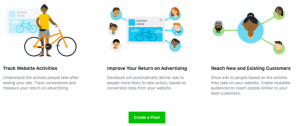
Utter the phrase “lead nurturing” and marketers will shudder in fear. Fear of being sent away to the dark corners of the office creating long and complicated email drip campaigns — the stuff marketing nightmares are made of.
But at the end of the day, complicated or not, lead nurturing is an absolute necessity if you want to turn a long list of leads into dollars for your business.
One often neglected tool a marketer has in their lead nurturing toolbox is social media. You heard me right.
When we think of social media we think of funny memes, one-minute videos, humblebrags, feel-good content and, most of all, top-of-funnel.
But as a lead nurturing tool?
Compared to a lengthy drip campaign built to educate and inform a customer until they’re ready to buy, social media has the advantage of being real-time and engaging. Not to say that email drip campaigns, but the more contact points you have with your leads the better.
In combination with a solid email drip strategy, social media can be THE place where your customers learn most about your company and the value you deliver.
We marketers usually wait until a lead indicates readiness to buy when they convert on a web form.
But readiness to buy can be triggered by so many different things. Maybe they saw a friend recommend your product on Facebook. Maybe they read a review on Twitter or watched a product showcase video on Youtube.
Social media is an awesome platform for lead nurturing, but only if your leads are there. The best way to be sure if your leads are also followers on social media is to…
- Run fan-only promotions and contests. A fan-only promotion will attract your leads to your social media pages and ensure that they are seeing your content there.
- Include social share buttons on all of your inbound and outbound content so your leads can follow you on their social media platform of choice.
If you’d like to maximize the output of your marketing efforts this article will break down how you can add social media to your lead nurturing strategy.
Interact and converse
Lots of us are guilty of scheduling some tweets in Hootsuite or Buffer and just letting them run (I know I am) but there is something to be said about having real conversations with your leads.
Imagine a situation where someone has converted into a lead and is one step closer to signing up for your online photography class. After the initial signup, the lead is taking some time to decide if your course is the right one for them.
Before they’re ready to register for your course they have a few questions that aren’t clearly addressed on your course page. Without much effort, they can jump onto your Facebook page and send you an instant message. Or they can head over to Twitter and ask you a question.
If you aren’t there to answer in a timely manner you can bet that your leads will start looking elsewhere.
Take a page from the Buffer social media team. They never miss on an opportunity to engage with their audience, whether it be in response to a question or a general comment. Your leads are interested in your brand and it helps to show that you’re interested in helping them.

I can’t tell you how many times Wishpond has been able to convert a customer just by being available on live chat, Facebook Messenger, and Twitter. Being there to answer questions and interacting with your audience can be the difference between a prospective converting or going elsewhere.
Got it. I want to start interacting with my audience but where do I start?
If most of your social media conversations are a one-way street, don’t worry. Creating more discussion doesn’t happen overnight. Asking a few questions once in a while isn’t going to magically create a long list of comments; it takes a while for you to build an audience invested enough to interact with your brand.
Engagement takes…
1) Consistency. Don’t pop in once in a while and expect your audience to engage with you. Be consistent in your posting time and your attendance. Be available to chat and be around when discussion is created by your audience. This is a long-term investment that will pay you back tenfold.
2) Interest. Talk about something other than your business. Be topical. Be funny and, most of all, be authentic.
Inbound.org is entirely made up of marketers having meaningful conversations about marketing strategy. Inbound uses Facebook as an outlet to start conversations that can then be moved onto their platform.

Highlight frequently-asked questions and helpful content
What’s better than answering your customer’s questions in real time?
Answering them before they’re even asked.
Along with the content you share on your social media channels, posting answers to frequently-asked questions is a great practice. Take a look at all the recurring questions you receive and turn that into a blog series that can be shared on social media.
A lead browsing their Facebook newsfeed may come across the answer they’ve been looking for and convert soon after.
To prevent an overload of self-promotional content, remember the 1:4 ratio. For every self-promotional piece you share, share four of value for your followers.
Canva does this perfectly. This post (below) on their Facebook page starts off with “Because you asked for it,” and is both helpful and promotional. They crowdsourced information from their users and implemented suggestions for a new feature. This allows them to highlight their product as well as the users helping them create a better one.

Highlight successful customers
Highlighting a past customer’s success can be just what you need to convert a lead into a paying customer.
Sometimes all they need is to be able to picture themselves using your product or service to really push them to convert.
Depending on which social media platform works best for your business, highlighting successful customers can be done in different ways:
- Case studies
- Infographics
- Videos
- Photography
There are few better examples of highlighting your successful customers than in the fitness industry. Orange Theory Fitness highlights the results achieved by their members to show that change is possible. Their goal is to show you that if you dedicate yourself to health and fitness, you too can achieve similar results.
Exclusive offers
A lead following you on social media can be given special access to exclusive offers that could convince them to make their first purchase.
Fans of your Facebook page, for example, can be given a special promo code to redeem on your website.
Consider running a fan-only Facebook contest for your fans to engage with them. Aside from improving your brand’s reach, a social media contest is a great way to quickly grow your social media audience.
This will go a long way to making your leads feel special and invested in your business.
Sol Republic offered a special discount for their Facebook fans on Father’s Day. By offering exclusive deals on their Facebook page, Sol Republic shows that it pays to be a Sol Republic fan.

Promote yourself
What’s the point of having a large following if you can’t promote yourself?
Mixing in some self-promotion along with valuable content is the formula for success. After demonstrating your value, authenticity, and credibility you’ll have built up trust in your customer.
Keeping with the 1:4 ratio that I mentioned earlier, promote the value you offer and present what problems your company has set out to solve. If you’ve managed to develop trust, your leads will have the confidence to convert into paying customers.
Don’t think of it as solely self-promotional — if it is genuine and helpful for your leads then they will find value in it.
One of my favorite mobile apps, Headspace, creates brilliant visual content on their Instagram that is inspirational and helpful as well as self-promotional.
They’ve found a comfortable medium with their social media content that their audience finds valuable and attention-worthy:
Putting the puzzle together
When we think about lead nurturing, we generally think about email. Granted, sending value-filled email after email is a proven strategy.
But it’s not the only strategy.
A marketer’s nurturing toolbox should include social media because us marketers can’t claim to know the exact point a buyer is ready to pull out their wallet.
Having social media as part of your nurturing strategy allows you to be in contact with your leads from a variety of directions and formats. A strong presence on social media that backs up your unique selling proposition plus some social proof is a one-two knockout punch.
How have you incorporated social media into your lead nurturing strategy? How have you done it?
Let me know in the comments below!
Digital & Social Articles on Business 2 Community(46)
Report Post






